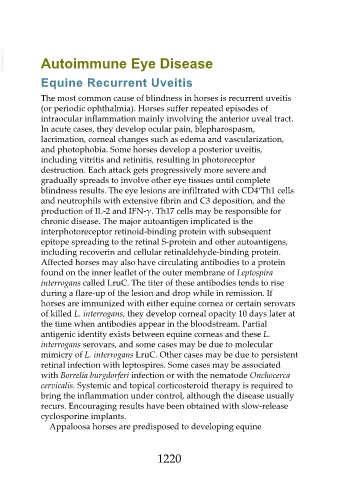Page 1220 - Veterinary Immunology, 10th Edition
P. 1220
VetBooks.ir Autoimmune Eye Disease
Equine Recurrent Uveitis
The most common cause of blindness in horses is recurrent uveitis
(or periodic ophthalmia). Horses suffer repeated episodes of
intraocular inflammation mainly involving the anterior uveal tract.
In acute cases, they develop ocular pain, blepharospasm,
lacrimation, corneal changes such as edema and vascularization,
and photophobia. Some horses develop a posterior uveitis,
including vitritis and retinitis, resulting in photoreceptor
destruction. Each attack gets progressively more severe and
gradually spreads to involve other eye tissues until complete
+
blindness results. The eye lesions are infiltrated with CD4 Th1 cells
and neutrophils with extensive fibrin and C3 deposition, and the
production of IL-2 and IFN-γ. Th17 cells may be responsible for
chronic disease. The major autoantigen implicated is the
interphotoreceptor retinoid-binding protein with subsequent
epitope spreading to the retinal S-protein and other autoantigens,
including recoverin and cellular retinaldehyde-binding protein.
Affected horses may also have circulating antibodies to a protein
found on the inner leaflet of the outer membrane of Leptospira
interrogans called LruC. The titer of these antibodies tends to rise
during a flare-up of the lesion and drop while in remission. If
horses are immunized with either equine cornea or certain serovars
of killed L. interrogans, they develop corneal opacity 10 days later at
the time when antibodies appear in the bloodstream. Partial
antigenic identity exists between equine corneas and these L.
interrogans serovars, and some cases may be due to molecular
mimicry of L. interrogans LruC. Other cases may be due to persistent
retinal infection with leptospires. Some cases may be associated
with Borrelia burgdorferi infection or with the nematode Onchocerca
cervicalis. Systemic and topical corticosteroid therapy is required to
bring the inflammation under control, although the disease usually
recurs. Encouraging results have been obtained with slow-release
cyclosporine implants.
Appaloosa horses are predisposed to developing equine
1220

